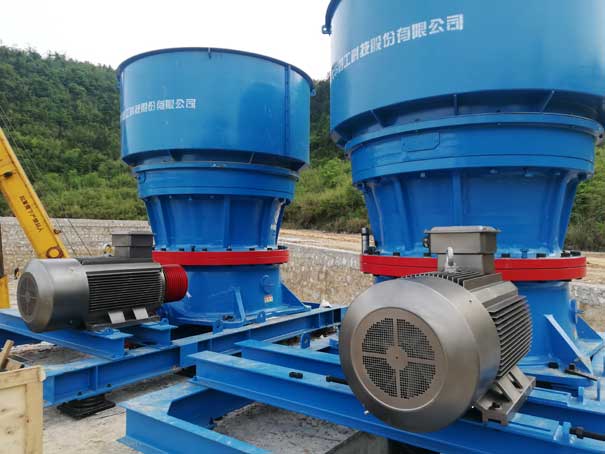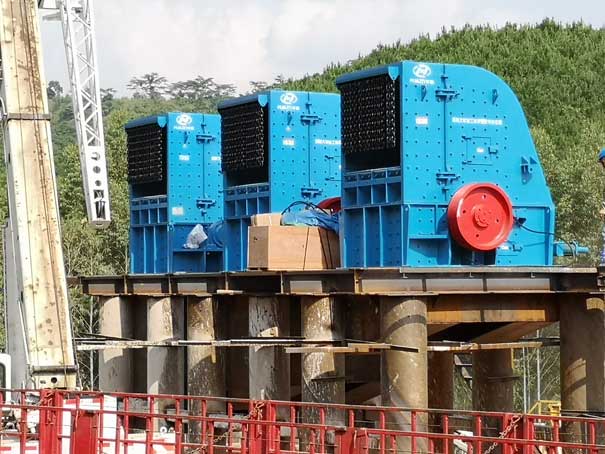Users who want to invest in sand and gravel production line know that the crushing of stone into gravel requires a process of one-stage crushing (coarse crushing) and two-stage crushing (medium crushing). One-stage crushing does not need to be considered too much. The "economical and practical" jaw crusher is often, the problem lies in the second-stage crushing. The two choices of impact crushing and cone crushing are quite troublesome.
The same is the second break; the obvious difference between the impact break and the cone breaker is the difference in the crushing principle and appearance structure, which is easy to distinguish. The impact crushing principle is adopted for the impact crushing. The material is repeatedly impacted and crushed between the hammer and the impact plate. The cone crusher uses laminated crushing. The rolling mortar wall continuously moves to the crushing wall, squeezing the material sandwiched between the two to make its shattered.
There are also many differences between the two in actual production, as follows:
1. Comparison of applicability of cone crusher and impact crusher.
Both impact crusher and cone crusher can be used as secondary crushing equipment, but the hardness of the materials crushed by the two is different. Generally speaking, cone crusher mainly crushes some harder materials, such as granite, basalt, tuff, river pebbles, etc., while impact crusher is used to crush smaller hard materials, such as limestone, etc. In a word, the impact crusher is suitable for crushing materials with low toughness and brittle materials with medium hardness and below, and the cone crusher is suitable for crushing hard materials.
Cone crusher is suitable for crushing materials such as iron ore, non-ferrous metal ore, granite, limestone, quartzite, sandstone, cobblestone, etc. in mining, building materials, metallurgy, sand and stone processing, road and bridge engineering and other industries. The outstanding features are high efficiency, deep cavity crushing, high degree of environmental protection.
The impact crusher is suitable for processing various coarse, medium and fine materials (granite, limestone, concrete, etc.) whose side length does not exceed 500mm and the compressive strength does not exceed 350 MPa. It is used in highway construction, water conservancy projects and construction. Crushed stone processing and other fields are widely used, and it is ideal processing equipment for aggregates.
2. The structure of cone crusher is different from that of impact crusher.
Cone crushers mainly include frame, horizontal shaft, moving cone, balance wheel, eccentric sleeve, upper crushing wall (fixed cone), lower crushing wall (moving cone), hydraulic coupling, lubrication system, and hydraulic system. Among them, the fixed cone and the movable cone are the parts that directly crush the material.
The impact crusher is mainly composed of a frame, a transmission mechanism, an impact plate and a rotor. The upper and lower parts of the frame are connected by bolts; the impact plate is suspended inside the crushing cavity; the plate hammer on the rotor is its most of the main wearing parts are of integral cast steel structure.
3. The applicable materials for cone crusher and impact crusher are different:
In fact, in terms of applicable materials and operating principles, impact crushing and cone crushing can be distinguished, as follows:
Cone crusher is selected for sand and gravel production line with high raw material hardness.
Granite, pebbles, basalt and other stones are all high-hardness sand and gravel materials. The special laminated crushing principle of cone crusher and the wearing parts made of high manganese steel have large crushing force, high compression resistance, wear resistance and durability. Features, not only the crushing efficiency is high, but also the later operation cost is low, but the initial investment will be slightly higher.
The sand and gravel production line whose raw material hardness is lower than the middle level is selected for impact crusher.
Limestone, coal grind stone, calcite and other stones belong to the sand and gravel raw materials with medium hardness. It is appropriate to choose the impact crushing principle of impact crushing. The material can be cube-shaped after being crushed by the impact board for multiple times, and the grain shape is complete. There are no cracks, and less stone dust is produced. The initial investment is not high, but the later period needs to be maintained and repaired on time.
4. The particle size and grain shape of the cone crusher and the impact crusher are different.
The discharging granularity of the materials crushed by the two types of crushers is different. Generally speaking, the cone crusher is smaller than the impact crusher. The particle shape of the impact crusher is good, the finished product has fewer edges and corners, and the powder is more; the cone crusher has more needles and flakes, but the particle shape is not good; in actual production, more cone crushers are used for beneficiation, while building materials and construction engineering. Compared with impact crusher, cone crusher has the characteristics of low energy consumption, large output and stable production, so cone crusher is often used in large-scale and high-yield production lines.
5. Compared with impact crushing, cone crushing is more in line with current market demand.
The price of cone crusher is more expensive than impact crushing, but its wearing parts have a longer life, avoiding the trouble of frequent replacement of parts. From a long-term perspective, cone crusher is more cost-effective than impact crusher.
It can be understood that the initial purchase cost of impact crusher is low, and the later maintenance cost is higher; the initial cost of cone crushing is high, and the later investment cost is lower. And the current environmental protection is strictly checked. In terms of environmental protection, the noise pollution and dust pollution of the impact crusher are large; the pollution of the cone crusher is relatively small, and it is more in line with the current requirements for the construction of green and environmentally friendly sand and gravel production lines.




